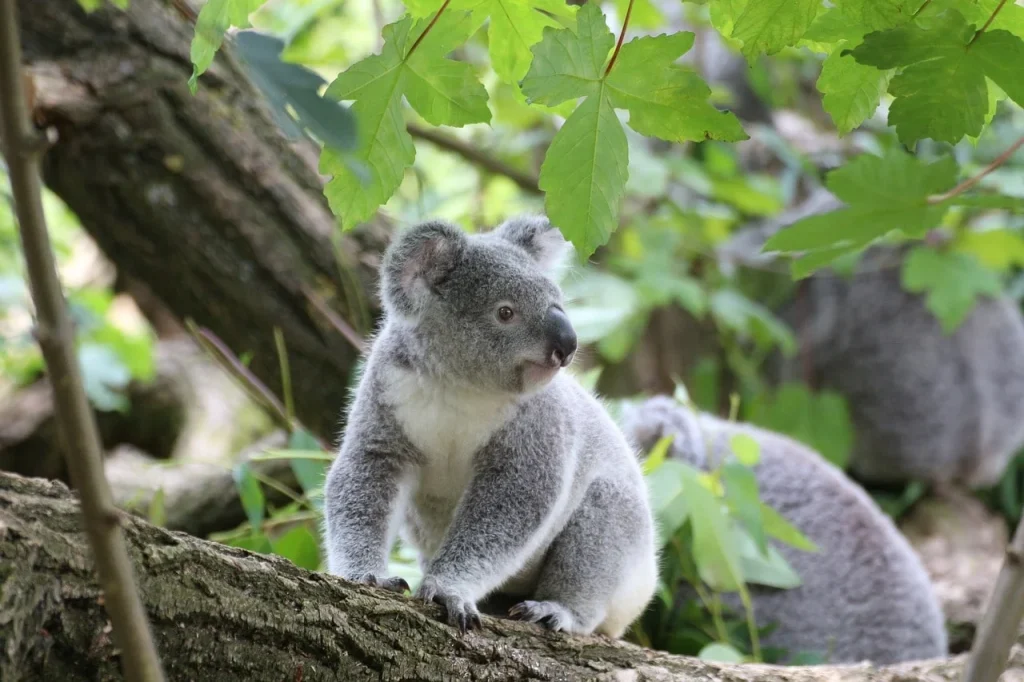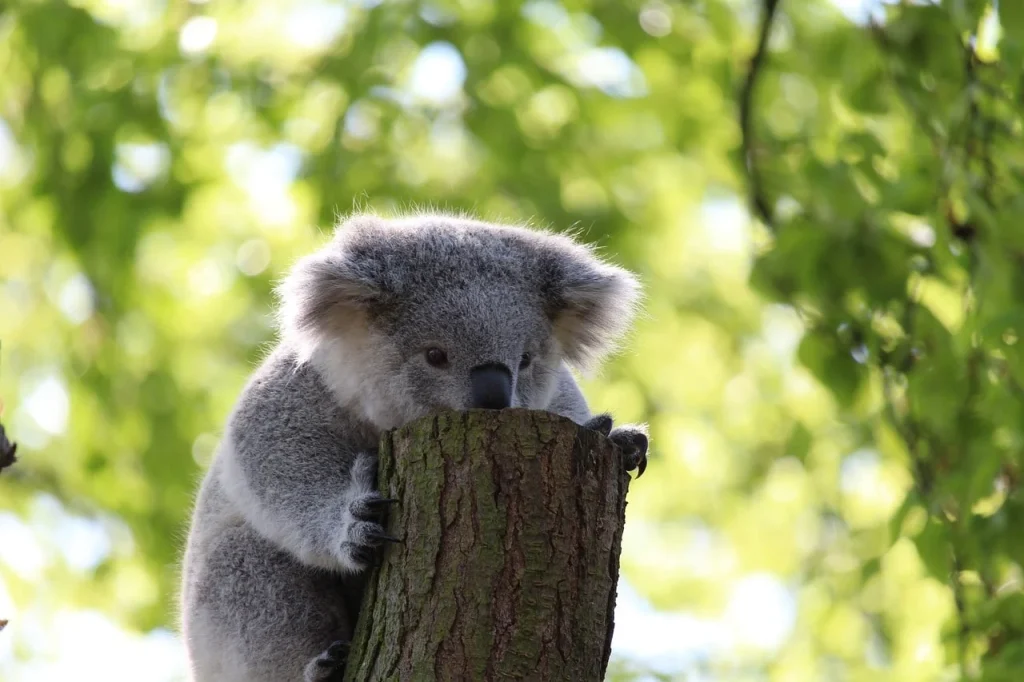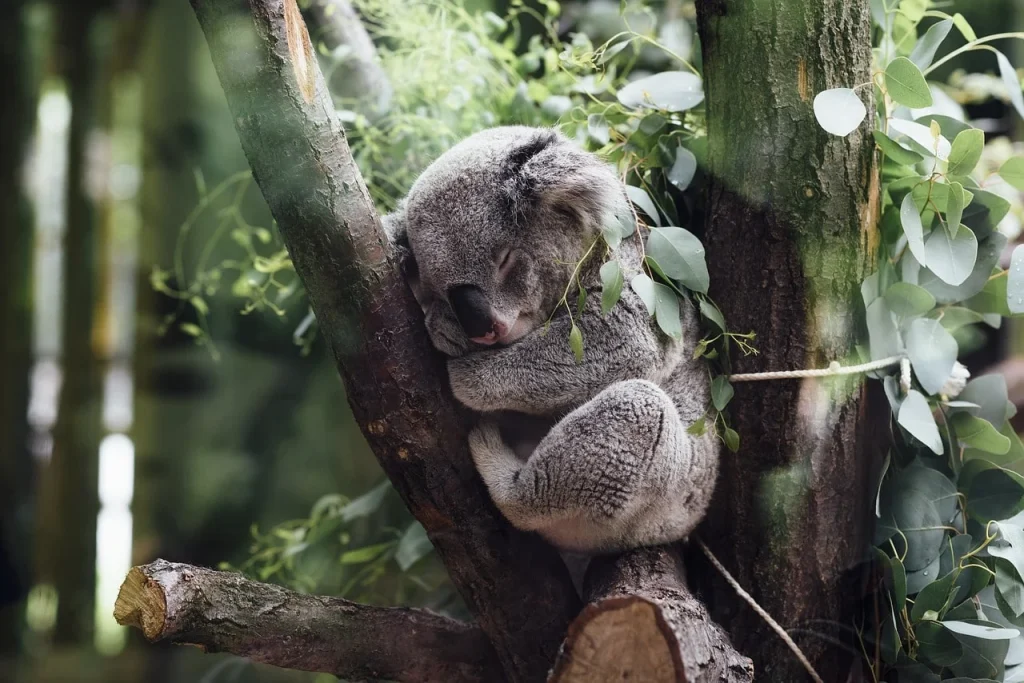Let’s talk about koalas! These cuddly creatures might look like bear cubs, but they’re actually marsupials, carrying their young in a pouch and munching on eucalyptus leaves all day.
In this blog, we’ll uncover some fun facts about koalas that will make you see them in a whole new light. For instance, did you know koalas have a very low-energy lifestyle, which perfectly explains their need for long naps. Let’s jump in.
Koalas are not bears; they are not plush toys; they are animals struggling to survive.
Tim Flannery
Koala Facts
Get ready to learn all about koalas! There’s a quiz at the end of this article, so pay close attention to each fact if you want to demonstrate your mastery on the subject.
- They can sleep up to 18-22 hours a day due to the low-nutrient content of their diet.
- Baby koalas, called joeys, are blind and earless at birth.
- Each individual prefers a particular type of eucalyptus and will travel extensive distances to find these specific trees.
- Their fingerprints are so similar to humans’ that they can contaminate crime scenes.
- Over 98% of their diet consists exclusively of eucalyptus leaves.
- They are not actually bears but marsupials, which means their young develop in a pouch.
- Their pouches open towards the bottom rather than at the top.
- Koalas have one of the smallest brain-to-body ratios among mammals, which may affect their ability to perform complex tasks.
- They have a low metabolic rate, which conserves energy but limits their mobility.
- Their vocalizations can be as loud as a motorcycle, helping them communicate over long distances.
- Each animal has a home range that overlaps with others, but they are mostly solitary creatures.
- Their noses are uniquely patterned, serving as a natural fingerprint to identify individuals.
- A specialized cecum helps them detoxify the chemicals found in eucalyptus leaves.

- Climatic changes and extreme weather like droughts and heatwaves are critical threats to their habitats.
- Chlamydia is a major disease affecting them, causing blindness and infertility.
- They drink water by licking it off the smooth surface of trees after rain, an action known as stemflow drinking.
- They have two opposable thumbs on each front limb for better gripping.
- Their populations are often fragmented due to urban development, which limits genetic diversity and increases disease spread.
- Koalas can swim if needed, to cross rivers or find new habitats.
- Their historical range has shrunken by 90% due to habitat destruction.
- Their fur has different thicknesses and color variations depending on their geographic location.
- Wildfires pose a significant threat to their survival, destroying the eucalyptus forests they depend on.
- When under stress, they produce a crying sound similar to that of a human baby.
- Mother koalas feed their joeys pap—a specialized form of feces—to prepare their stomachs for eucalyptus leaves.
- Despite their cuddly appearance, they are quite capable of defending themselves using sharp claws and teeth.
- Their social structures are complex, often involving intricate interactions and territorial disputes.
- Ailments such as kidney disease are prevalent due to their high-mineral diet.
- Conservation efforts for them include establishing corridors between fragmented habitats to enhance gene flow and reduce inbreeding.

- Tree planting initiatives are crucial to their survival, aiming to restore lost forest areas.
- They use scent marking to communicate territorial boundaries and reproductive status.
- Eucalyptus oil is mildly psychoactive, which may calm the animals as they eat.
- Researchers use drones equipped with thermal cameras to track their populations in the wild.
- They evolved from wombats-like ancestors, adapting to a life in the trees.
- Their low-energy lifestyle means that they rarely need to descend from trees, except to move between them or drink.
- Teeth wear down over time, which can lead to starvation in older individuals.
- Young joeys communicate with their mothers through soft purring noises.
- They can live up to 18 years in the wild, though many do not survive that long due to various threats.
- Genetic studies reveal a low genetic variability among populations, which complicates conservation strategies.

- During mating season, males emit a loud snore-and-bellow sequence to attract females.
- Joeys leave the pouch for the first time at about six months, but they remain close to their mothers for another six months.
- Their nocturnal lifestyle helps them avoid the heat of the day and conserve water and energy.
- Historically, they were hunted for their thick fur, which was highly prized in the early 20th century.
- Koalas require large amounts of habitat—a single individual may use up to 100 trees.
- Their population in some areas is considered “functionally extinct”, meaning they may not recover without significant intervention.
- Sanctuaries and rescue organizations play critical roles in rehabilitating injured and sick individuals.
- They have one of the slowest reproductive rates among mammals, which complicates recovery from population declines.
- Climate change impacts their survival by causing more frequent and severe heat stress events.
- Specialized hospitals exist to treat diseases and injuries specific to them, including burns from wildfires.
- Historical records indicate that they were once widespread across the entire mainland of Australia, not just the eastern regions.
- Their ability to digest eucalyptus is supported by specially adapted intestines that are up to two meters long.
Koala Myths

Having learned all these interesting facts about koalas, it’s time to explore what’s true and what’s not. We’ll debunk the myths and confirm the truths in the following section.
- Koalas Sleep All Day Because They Are Lazy
It is often thought that they are lazy, but in reality, their high-energy requirements and low-nutrient diet necessitate long periods of sleep. Up to 20 hours of sleep per day are needed to conserve energy. - Koalas Are Bears
Despite their common name, “koala bear,” koalas are not bears at all. They are marsupials, which means that their young are born immature and develop further in the safety of a pouch. - Koalas Can Be Kept as Pets
They are protected by law and are not allowed to be kept as pets. Their specialized dietary and health needs make them suitable only for the wild or specialized care in conservation centers. - Koalas Only Eat Eucalyptus Leaves
While eucalyptus leaves are the primary component of their diet, they are known to consume leaves from other tree species as well. This diet is crucial for their digestion and overall health. - Koalas Are Found All Over Australia
They are native to specific regions in Australia, primarily found in the eastern and southern coastal areas. Their habitat is limited to these regions due to the availability of suitable eucalyptus forests.
No products found.
Koala Quotes

We continue with the quotes section. Feel free to share yours in the comments so I can add them to the list as well.
Koalas are the soul of the Australian bush, and protecting them protects many other species.
Jane Goodall
Jane Goodall, a world-famous primatologist and anthropologist, stresses the ecological significance of koalas for preserving biodiversity.
The koala does not argue or play politics; it just clings on silently, emblematic of nature’s plea for help.
Barry Richardson
As a wildlife expert, Barry Richardson poignantly captures the koala’s silent struggle in the face of environmental changes.
Watching a koala in its natural habitat is a reminder of how life flows smoothly when left undisturbed.
Miranda Richardson
Actress and animal rights advocate Miranda Richardson speaks to the peaceful existence of koalas in nature and the importance of conservation.
Koalas teach us that the key to happiness is to rest often, eat your greens, and cherish your leaves.
Phillip Adams
Broadcaster and film producer Phillip Adams humorously draws life lessons from the koala’s simple, leaf-eating lifestyle.
Saving the habitat of a koala is no different than saving our own homes.
Steve Irwin
Famous wildlife conservationist Steve Irwin equates the protection of koala habitats with preserving human environments, highlighting our interconnectedness with nature.
Koala FAQ

You’ve explored some quotes about koalas, and now it’s time to dive into the FAQs. Pay close attention—this section is key to acing the upcoming quiz!
- Why do koalas eat eucalyptus?
They eat eucalyptus leaves because they are the main component of their diet and provide all the necessary nutrients and moisture they need. Despite the leaves being low in protein and high in fibrous material, koalas have a specialized digestive system that detoxifies the poisonous compounds found in eucalyptus. - Are koala bears dangerous?
They are generally not dangerous, as they are docile and spend most of their time sleeping in trees. However, they can defend themselves with sharp teeth and claws if they feel threatened. - Can koala bears swim?
They can swim if needed, but they rarely do so because they get all the hydration they need from eucalyptus leaves and prefer to remain in their arboreal habitats. - Are koala bears endangered?
Yes, they are classified as vulnerable to extinction. Their populations are declining due to habitat destruction, bushfires, and diseases such as chlamydia. - What is the lifespan of a koala in the wild?
The lifespan of a koala in the wild is generally around 10 to 15 years. Factors like habitat loss and disease can impact their longevity.
No products found.
Koala Quiz

Welcome to the Ultimate Koala Quiz! Beware, if you don’t score any points, we’ll send a real koala to rearrange your furniture — and they’re notoriously bad decorators!
Koala Merch
If you are a true fan of koalas, then you definitely need to check out our merchandise. You can find T-shirts, hoodies, mugs, and tote bags for your favorite designs. Feel free to check out all the other designs in our shop.
Conclusion
From their fuzzy ears to their tree-hugging habits, koalas capture our hearts and highlight the importance of conservation.
As we continue to learn about these remarkable marsupials, let’s commit to protecting their habitats and ensuring a future where koalas thrive in the wild. Till next time, stay curious and explore more. Cheers.


